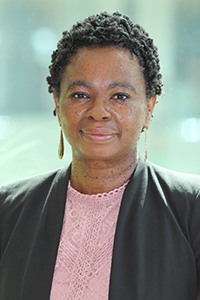Where Electronics and Biology Merge: Eleboeba E. May Receives NSF SemiSynBio-III Award
There are many ways researchers can alter biology for human health or agricultural benefits, such as engineering DNA or using drugs and other chemicals. However, the emerging field of bioelectronics takes a different approach, which could provide alternative treatment options for hard-to-treat conditions. Elebeoba E. May, a Wisconsin Institute for Discovery (WID) and Medical Microbiology and Immunology (MMI) Associate Professor, is interested in using electricity as an external stimuli to regulate biological cells, without changing the DNA sequence. May will investigate the intersections between electrical circuits and biology in a three-year, $1.5 million grant from the National Science Foundation (NSF) Semiconductor Synthetic Biology Circuits and Communications for Information Storage (SemiSynBio-III) program.
Electronics–computers, tablets, smartphones–have been designed for multiple purposes which can be carried out through apps or software. To update or add a function, users change these tools, rather than redesign the entire computer system for a specific process. This is the direction May wants to move biology. “For me, biology is an engineerable system,” she says. “We want to use it to do many different things, without engineering at the DNA level, but modulating the cell to communicate and actuate by interfacing with engineered DNA.”

Elebeoba E. May
Engineering biological systems without editing DNA will have clinical, agricultural, and technological impacts. May is interested in understanding how pathogens interact with host immune systems to better fight infections, but other scientists might apply this work to microbial communities, such as the gut or soil microbiome.
May’s work will focus on developing computer models of interactions between electrical stimuli and biological cells to establish metrics for efficient data flow through these systems. These models will help develop experiments on electrical modulation of biological cells in the lab.
“Simulation-enabled design will allow us to gain a higher-level, mathematical representation of what’s going on in these circuits,” says May. “This will help address some of the engineering challenges of putting the entire system together.”
The SemiSynBio-III research proposal aims to use May’s computer models to develop biocompatible materials that convert electricity to signals recognized by biological cells. These “biohybrid” devices may be able to listen to immune or bacterial cells to combat infections or heal wounds.
Next, May and her collaborators from the University of Maryland and Georgia Institute of Technology will create biological cells capable of converting electrical signals into chemical signals recognizable by other cells, which will enable greater communication for disease treatment. Eventually, the team will create biological cells capable of using electrical signals to observe their environment and independently change how cells interact with the environment.
Another important factor of the award is serving historically underserved students. In addition to the research, the grant will also develop a summer school with lectures and hands-on activities to expose undergraduate and graduate students to the bioelectronics field and build community.
“Synthetic biology has been around for a while, but it’s largely been concentrated on the coasts,” says May. “There’s not a lot of [synthetic biology or bioelectronic research] in the Southeast, South, or Midwest. The idea of the summer schools is to engage more students and early-career trainees in this field and provide an opportunity for them to interact.”
The interdisciplinary nature of this project excites May. Working with a team of synthetic biologists, chemical engineers, and computational biologists will enhance ways to control biology for biomanufacturing and medical interventions. Though “there’s a lot that we don’t yet understand,” May says, “I think all these tools are moving us towards a direction that’s extremely exciting.”





